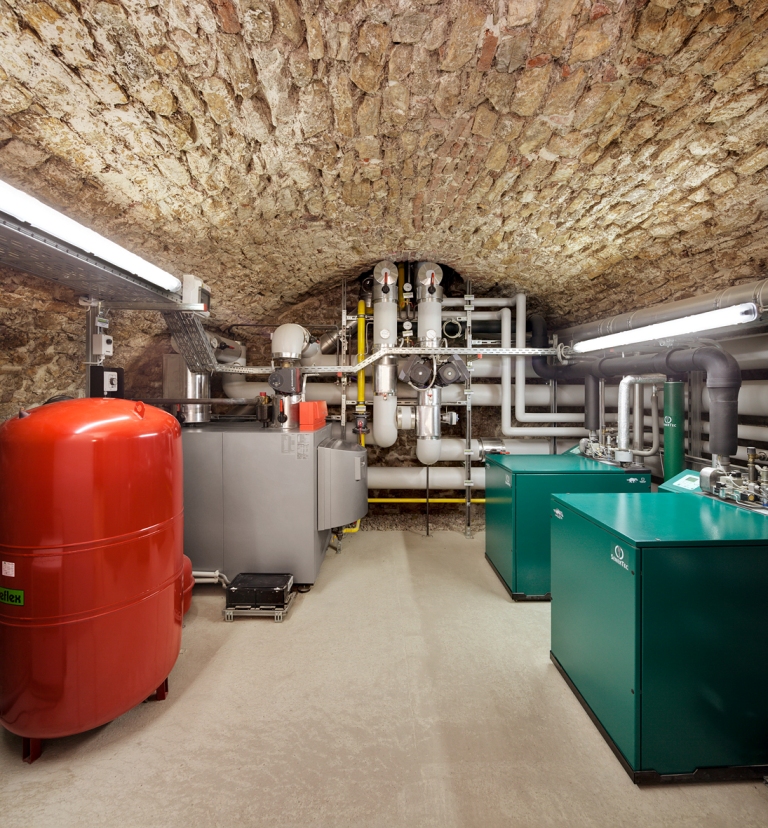A blockcogeneration plant (CHP) is a modular system for generating electrical energy and heat, which is preferably operated at the point of heat consumption, but can also feed useful heat into a local heating network. It uses the principle of cogeneration or cogeneration.

Mini CHP in the Kulturstadel Vohburg (Gammel Engineering)
Combustion engines, i.e. diesel, vegetable oil or gas engines, but also gas turbines, steam turbines, steam engines, ORC turbines, ORC engines, fuel cells or Stirling engines can be used.
Gammel Engineering has developed the Kombi Power System ® , a modular system concept that is independent of technologies and energy sources and is configured and realized exclusively according to customer requirements.
The higher overall degree of utilization (energy efficiency) compared to the conventional combination of local heat generation for space heating or processes and a central power plant results from the fact that the process-related heat generated during electricity generation is used directly at the point of generation. Depending on the size of the plant and the technology used, the efficiency of electricity generation is between 10 and more than 60%.
GraphicIf the heat is used completely and locally, an overall efficiency of 80% to 90% can be achieved with regard to the primary energy used, and up to 120% with calorific value use, depending on the fuel. condensing boilers achieve efficiencies of around 100%, but cannot generate electricity.
Common CHP modules have electrical outputs of between one kilowatt (kW) and several tens of megawatts (MW). Below 50 kW, they are also referred to as mini combined heat and power (mini CHP), below 15 kW as micro CHP. Mini and micro CHP are used in single and multi-family homes, in businesses and in housing developments. Combined heat and power generation is also used in cogeneration plants. Combustion heat outputs there range from around 100 kW to several hundred MW.
Combined heat and power plants are usually connected to the public power grid so that peak loads can be covered and excess production from the CHP plant can be fed into the power grid. The public grid can also offer corresponding redundancy and therefore security of supply.Operating concepts:Heat-led
If the power output of the CHP unit is based on the heat demand in the supply area, it is a heat-controlled CHP unit. In modular systems, individual gensets are switched on or off as required by controlling the heat output. In configurations with only one unit, either its power output is regulated accordingly or a heat storage tank is charged in intermittent operation. The storage tank is often designed so that the motor requires at least one hour to fully charge. As the maintenance intervals are based on the operating hours of the system, intermittent operation is usually the more economical mode of operation compared to modulated operation. As far as possible, the electricity generated by such systems is consumed by the system itself, marketed directly (market premium model / management premium) or fed into the public grid if renewable energies are used.
Electricity-ledWith a current-controlled CHP unit, the power output is based on the electricity demand. The heat that cannot be used during this period, if available, is buffered in a heat accumulator for later use or released into the environment via a balance cooler as waste heat, although this reduces efficiency. This operating mode is often used in island grids. In Germany, a number of CHP units are operated with renewable raw materials as fuel, using electricity: The statutory feed-in tariffs for the electricity produced (Renewable Energy Sources Act, EEG for short) made it possible for operators to maximize profits in the short term by producing as much electricity as possible. The utilization of the resulting heat was neglected in many biogas plants and large wood-fired combined heat and power plants often initiated by financiers. As a result, these plants lack the revenue from the sale of heat, which can largely compensate for fuel price developments. The only product, electricity generated in accordance with the EEG, is subject to a fixed price guarantee for 20 years when fed into the public grid - price increases for biomass can therefore not be compensated for on the revenue side. The recent amendments to the EEG have minimized this energy-wasting option.
Grid-ledIf the output level is specified by a central point for several systems, this is referred to as a grid-connected CHP unit. The central office optimizes the deployment planning of the decentralized CHP units across the system based on economic boundary conditions, such as joint gas and residual power purchase agreements. Grid management is the core idea of a virtual power plant. As with electricity management, a storage system must be integrated to decouple heat generation and load over time. This mode of operation is particularly important when marketing CHP electricity according to the balancing current principle.
Sources :
Wikipedia http://de.wikipedia.org/wiki/BHKW